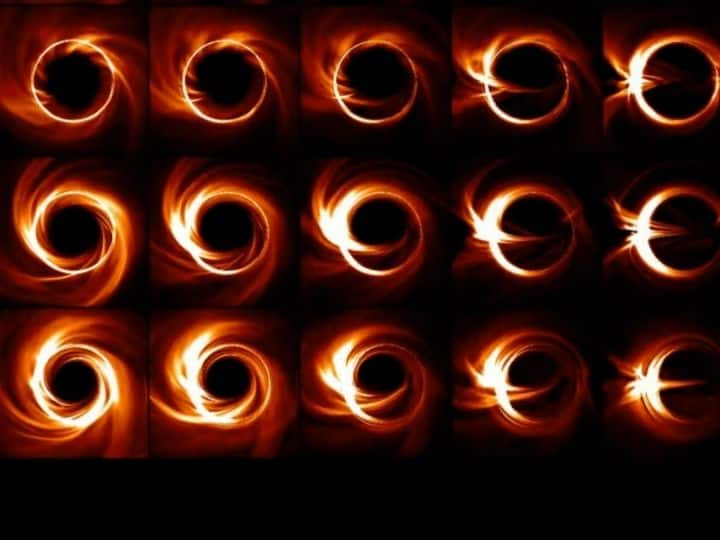'Wherever We Look, We Should See Donuts': Scientist After Black Hole At Milky Way's Centre Is Imaged
On May 12, the Event Horizon Telescope (EHT) Collaboration presented the second image of a black hole. It is the image of Sagittarius A*, the black hole located at the centre of our Milky Way galaxy.

New Delhi: When a feat is achieved for the second time, scientists usually do not feel the same excitement as the first time. However, this is not what happened in the case of Sagittarius A*, the supermassive black hole at the centre of our Milky Way galaxy, and the second black hole to be imaged.
In 2019, the image of M87*, a supermassive black hole in a galaxy more than 50 million light-years from Earth, was captured, and marked the first time a black was snapped. On May 12, 2022, the Event Horizon Telescope (EHT) Collaboration presented the second image of such an object. This time, it was the image of Sagittarius A*, the black hole located at the centre of our Milky Way galaxy.
The two images of an orange-glowing ring surrounding a black shadow look almost indistinguishable to the casual observer. However, it is the fact that the two images are indistinguishable that has astrophysicists gushing with awe.
What Astrophysicists Say About Black Hole Images
In a statement issued by University of Arizona in the United States, EHT Science Council member Feryal Özel said she wished she could say that when the first image of the black was obtained three years ago, it did not get any better. But this is actually better, she said.
Özel added that astrophysicists see a bright ring surrounding complete darkness, the telltale sign of a black hole. Now, they can confirm they are looking directly at the point of no return.
University of Arizona professor of astronomy and physics and principal investigator of the international Black Hole PIRE (Partnerships for International Research and Education) Project Dimitrios Psaltis said the fact that the light appears like a ring, with the black shadow inside, tells everyone that it is purely gravity. The Black Hole PIRE Project is a National Science Foundation-funded international research and education project aimed at revolutionising worldwide efforts to study black holes.
Speaking about the gravity inside a black hole, Psaltis said it is all predicted by Einstein's theory of general relativity, the only theory in the cosmos that does not care about scale.
Black Holes Appear Like ‘Donuts’
"Wherever we look, we should see donuts, and they all should look more or less the same," Psaltis said.
He explained that the reason why it is important for black holes to look more or less the same is that it confirms the prediction by Einstein's theory of general relativity.
According to the statement, Özel said she "fell in love" with Sagittarius A* 20 years ago, when she was a graduate student. She wondered what it would take to actually look at a black hole directly, and what one would see.
She published a seminal paper in 2000 with Psaltis. In that paper and a follow-up paper published in 2001, she identified M87*, the first black hole ever to be imaged, and Sagittarius A* as the two ideal black holes that presented even a remote chance of having their pictures taken. This contributed to the groundwork for an Earth-sized observatory that is known as the Event Horizon Telescope, the statement said.
Why M87* And Sagittarius A* Look Almost Identical
Since M87* is 1,500 times more massive but 2,000 times farther away than Sagittarius A*, the two appear roughly equal in size in the sky. However, despite the fact that they look almost identical, they are entirely different monsters.
Difference Between M87* And Sagittarius A*
M87* has the mass of six billion Suns, and is of gargantuan size. The entire solar system would fit inside the event horizon of M87*, also known as a black hole's point of no return. The event horizon is the boundary defining the region of space around a black hole from which nothing, not even light, can escape. Sagittarius A*, which is located a mere 25,000 light-years from Earth, is puny in comparison to M87*.
At only four million solar masses, Sagittarius A* is small enough to fit into the orbit of Mercury. If the two black holes are lined up for a photograph opportunity, M87* would fill the frame, while Sagittarius A* would disappear entirely, the statement said.
M87* voraciously devours surrounding matter, including entire stars, and launches a jet of energetic particles that torches across its galaxy. Meanwhile, Sagittarius A* has a comparatively minimal appetite. If the black hole were a person, it would consume the equivalent of a grain of rice every million years, according to researchers.
Images Of Black Holes With Vast Differences In Size Look Similar
Psaltis said that one of the most fundamental predictions of Einstein's theory of gravity is that the image of a black hole scales only with its mass. For instance, a black hole 1,000 times smaller in mass than another will have a very similar image that will be just 1,000 times smaller. Psaltis explained that the same is not true for other objects.
Citing the example of a rat and an elephant, he said that in general, small things typically look very different from big things, and that is no coincidence.
The statement said that nature's laws of scale dictate that when two entities are of vastly different sizes, they typically look different from each other, unlike black holes, which scale without changing their appearance. This means that no matter the size of black holes, their images look very similar to each other.
Psaltis explained that their stark simplicity is what makes the two black hole images so important, because they confirm what until now had only been predicted by theory — Black holes appear to be the only objects in existence that only answer to one law of nature, which is gravity.
According to Psaltis, if scientists could take a picture of a truly small black hole of about 10 solar masses, and compare it to M87*, which has six billion solar masses, the two pictures would look very similar. However, it will not be possible to take a picture of a black hole having about 10 solar masses because even the Earth-sized EHT does not have the necessary resolution.
The 'Goldilocks Black Holes'
Black holes have a gravitational pull so strong that not even light can escape, making them impossible to see by definition. Also, these astronomical wonders are such alien objects that even Albert Einstein struggled to reconcile their existence. Astronomers were able to image black holes because they used radio telescopes that detect electromagnetic waves emitted by the gas swirling around the black hole.
Özel said that if one were in space looking at the black hole, they would see nothing. The glow is in wavelengths the eye cannot see, she said.
This is the reason why M87* and Sagittarius A* were identified as the only feasible targets for the Event Horizon Telescope in the publication authored by Özel and Psaltis more than 20 years ago.
Özel said one could say both M87* and Sagittarius A* are 'Goldilocks of black holes'. Their environments are just right, and that is why scientists can see through them, she explained.
A Goldilocks black hole is an intermediate-sized black hole that falls right between the smallest and biggest black holes ever found, and is a missing piece connecting two types of black holes. Black holes are either made from stars, or are supermassive. The latter are located at the centre of a majority of galaxies.
What Is Next?
Özel and Psaltis consider black holes natural laboratories that allow them to test general relativity and may even bring them closer to a theory unifying gravity with quantum mechanics, which, until now, had remained elusive.
Özel said that getting to the image was not an easy journey. The image was the result of a globe-spanning collaboration, petabytes of data, and more involved algorithms that had been dedicated to most scientific endeavours before. All this allowed scientists to analyse and confirm the final image of Sagittarius A*.
Özel said the EHT Collaboration is interested in how black holes change over time.
She has some questions such as how the black hole would change if one looked at the source one day versus the next, or one year versus the following year, how much light it would emit in different wavelengths, and how scientists could use their observations to understand the black hole's environment.
According to Özel, one of the key points of this collaborative effort is to test general relativity and find out where its limit is, if there is one.
Related Video
Southern Rising Summit 2024: How Important is Self-Awareness? Insights from Anu Aacharya | ABP LIVE






































